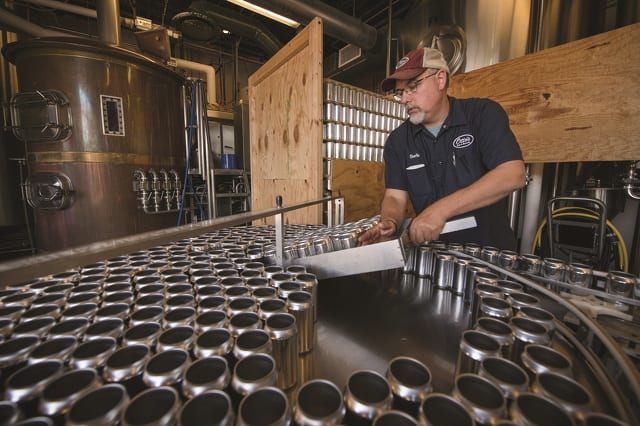At one time, there seemed to be little debate: Beer was simply better when it came from a bottle than a can. Whether that was a fact or just the thinking because bottles were “cooler” can be discussed.
But what has become a reality in the beer-brewing business these days is that more brewers are putting their beer into cans instead of, or in addition to, bottles. And it’s not just the beer industry; some wineries are actually starting to can their wine.
Some brewers, such as Otto’s Pub & Brewery in State College, invested the money and transformed their distributive line so it’s now almost exclusively canning.
“We can everything except Jolly Roger and Keewaydin Cider because we have a lot of packaging on hand for cider, and I feel Jolly Roger will age better in a bottle, as some people like to do,” says Charles Schnable, co-owner and head brewer at Otto’s.
Otto’s began canning last year. Schnable says the decision to make the switch was based on a number of factors.
“We made the decision based on lower costs for packaging, more flexible amounts – we can do much smaller runs – more accepted at events, greater storage ability – 80 cases where before it was 50 – greater shelf life, no light issues (light causes staling), and cans are generally quieter and safer than glass during packing,” he says.
In 2014, Troegs Brewery in Hershey began canning two of its more popular year-round beers, Perpetual IPA and Troegenator Double Bock. The switch happened right when the beer industry started seeing a jump in brewers doing more canning.
According to a 2017 story from the Brewers Association for Small & Independent Craft Brewers, cans were 5.6 percent of the volume for craft brewers in 2013. In 2016, the percentage was at 17.2.
“We’d been thinking about canning for a few years, but were on the fence,” says John Trogner, co-owner and brewmaster of Troegs. “Because we were already in the process of ordering two new bottling lines, it made sense from a cost and timing perspective to move forward and get all three at the same time.”
Trogner says he believes there are many reasons why more brewers are switching to canning, including cans being lighter than glass bottles and easier to recycle, and cans can go places such as beaches, tailgating, and on camping trips where glass may be prohibited.
In his story for the Brewers Association looking at the can versus bottle statistics, Bart Watson, who is the chief economist for the Brewers Association, wrote that bottles still dominate craft volume, but cans have grown faster. He added that the desire for more package diversity “suggests opportunities for both package types, particularly as craft brands continue to build in volume and velocity.”
Troegs continues to have the majority of its sales come from its bottled beer, but it also recognizes what people want.
“We recognize that cans are an excellent packaging alternative, especially given the active lifestyle of many craft-beer drinkers,” he says. “Craft-beer drinkers are into cycling, hiking, camping, and a variety of other activities. Cans offer us flexibility in the way we present beers to our consumers.”
When it comes to flavor and quality of taste, Schnable and Trogner agree that there is no difference, and cans offer the advantage of taking away light that causes beer to become stale.
“Cans are better at keeping beer safe from one of its biggest adversaries: sunlight,” Trogner says. “So canned beer will have a more stable shelf life, allowing it to stay fresher for a longer period of time.”
Schnable adds, “There should be no difference in flavor from bottles other than some people’s … perceptions of cans versus bottles.”
While Schnable says that “you see just about everything under the sun coming in cans nowadays,” he doesn’t know whether it’s just a trend for the near future or something that will last.
“It seems that cans are going to be the ever-increasing package for the craft-brewing industry for the near term,” Schnable says. “I see more and more breweries selling their bottling lines to make the switch. Who knows? Maybe it will switch back in 10 years.”
David Pencek is a freelance writer in State College.



